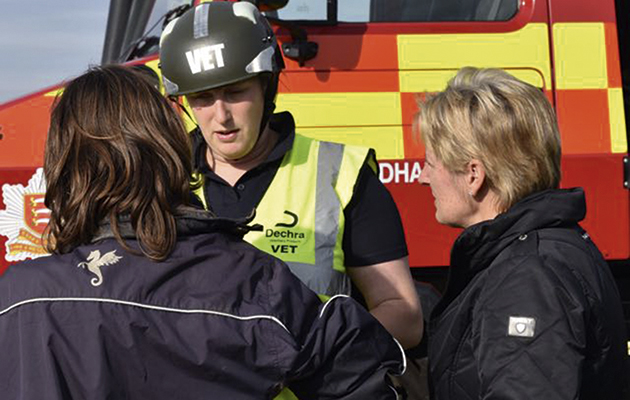We hope it never happens, but if your horse was caught in a fire, what would be the implications and how would we restore them to health? Andrea Oakes investigates
ONE of the most heartbreaking aspects of a yard fire is that a horse lucky enough to be freed from a burning stable will often refuse to leave it, or will try to run back to it, in the mistaken belief that his stable is a place of safety. The chaos and confusion as the flames take hold is something we hope never to witness.
Hope is not a strategy, however, when it comes to keeping horses safe. Instead, prevention and planning will minimise risk and offer the best chance of avoiding a catastrophe.
According to Jim Green, who brings years of firefighting experience to his role as director of the British Animal Rescue and Trauma Care Association (BARTA), the typical yard set-up presents a perfect storm for an inferno.
{"content":"PHA+4oCcTW9zdCBoYXZlIGFuIGFidW5kYW5jZSBvZiBjb21idXN0aWJsZSBtYXRlcmlhbHMsIHN1Y2ggYXMgd29vZCwgZm9yYWdlIGFuZCBiZWRkaW5nLCBidXQgbGFjayBzbW9rZSBkZXRlY3RvcnMsIGZpcmUgYWxhcm1zIG9yIHNwcmlua2xlciBzeXN0ZW1zIOKAkyB1bmxpa2UgYXQgY29tbWVyY2lhbCBwcmVtaXNlcyzigJ0gSmltIGV4cGxhaW5zLiDigJxCeSB0aGUgdGltZSBzb21lb25lIHJlYWxpc2VzIHRoYXQgZmlyZSBoYXMgYnJva2VuIG91dCwgaXTigJlzIG9mdGVuIHRvbyBsYXRlLiBUaGUgdXN1YWwgYWR2aWNlIHdpdGggYSBidWlsZGluZyBmaXJlIGlzIHRvIGdldCBvdXQgYW5kIHNodXQgdGhlIGRvb3I7IHdpdGggc3RhYmxlcywgaXQgY2FuIGJlIGRpZmZpY3VsdCB0byBjb250YWluIHRoZSBmbGFtZXMu4oCdPC9wPgo8cD5UaGUgZmFjdHMgYXJlIGZyaWdodGVuaW5nIOKAkyBhIGZpcmUgaW52b2x2aW5nIGRyeSBtYXRlcmlhbHMsIHN1Y2ggYXMgc3RyYXcgYW5kIHNoYXZpbmdzLCBjYW4gZG91YmxlIGluIHNpemUgZXZlcnkgNjAgc2Vjb25kcy48L3A+CjxwPjxkaXYgY2xhc3M9ImFkLWNvbnRhaW5lciBhZC1jb250YWluZXItLW1vYmlsZSI+PGRpdiBpZD0icG9zdC1pbmxpbmUtMiIgY2xhc3M9ImlwYy1hZHZlcnQiPjwvZGl2PjwvZGl2PjxzZWN0aW9uIGlkPSJlbWJlZF9jb2RlLTMxIiBjbGFzcz0iaGlkZGVuLW1kIGhpZGRlbi1sZyBzLWNvbnRhaW5lciBzdGlja3ktYW5jaG9yIGhpZGUtd2lkZ2V0LXRpdGxlIHdpZGdldF9lbWJlZF9jb2RlIHByZW1pdW1faW5saW5lXzIiPjxzZWN0aW9uIGNsYXNzPSJzLWNvbnRhaW5lciBsaXN0aW5nLS1zaW5nbGUgbGlzdGluZy0tc2luZ2xlLXNoYXJldGhyb3VnaCBpbWFnZS1hc3BlY3QtbGFuZHNjYXBlIGRlZmF1bHQgc2hhcmV0aHJvdWdoLWFkIHNoYXJldGhyb3VnaC1hZC1oaWRkZW4iPg0KICA8ZGl2IGNsYXNzPSJzLWNvbnRhaW5lcl9faW5uZXIiPg0KICAgIDx1bD4NCiAgICAgIDxsaSBpZD0ibmF0aXZlLWNvbnRlbnQtbW9iaWxlIiBjbGFzcz0ibGlzdGluZy1pdGVtIj4NCiAgICAgIDwvbGk+DQogICAgPC91bD4NCiAgPC9kaXY+DQo8L3NlY3Rpb24+PC9zZWN0aW9uPjwvcD4KPHA+4oCcUHJvZHVjdHMgb2YgY29tYnVzdGlvbiBhcmUgbmFzdHks4oCdIHNheXMgSmltLiDigJxIb3QgYWlyIHJpc2VzLCBhbmQgd2hlbiBob3JzZXMgYXJlIHNjYXJlZCB0aGV5IGxpZnQgdGhlaXIgaGVhZHMgYW5kIHRoZWlyIHJlc3BpcmF0aW9uIHJhdGUgaW5jcmVhc2VzLiBJbiBhbiBlbmNsb3NlZCBzcGFjZSwgdGhleSBhcmUgYXQgcmlzayBmcm9tIHRveGljIGFuZCBvZnRlbiBzdXBlcmhlYXRlZCBzbW9rZSwgYXMgd2VsbCBhcyB0aGUgcGh5c2ljYWwgZWZmZWN0cyBvZiByYWRpYW50IGhlYXQuPC9wPgo8cD7igJxPdGhlciBidWlsZGluZyBtYXRlcmlhbHMgd2lsbCBjb250cmlidXRlOyB0aGUgZmVsdCB1bmRlciBhIHRpbGVkIHJvb2YgY2FuIG1lbHQgYW5kIGRyaXAgb250byB0aGUgYW5pbWFscyBiZWxvdywgZm9yIGV4YW1wbGUsIGNhdXNpbmcgYnVybnMs4oCdIGhlIGFkZHMuIOKAnFNtb2tlIGZyb20gbWF0ZXJpYWxzIHN1Y2ggYXMgcnViYmVyIGFuZCBmZWx0IHdpbGwgYWxzbyBjcmVhdGUgaHVnZSB0b3hpY2l0eS7igJ08L3A+CjxwPkNhdXNlcyBjYW4gcmFuZ2UgZnJvbSBzcG9udGFuZW91cyBtdWNrIGhlYXAgY29tYnVzdGlvbiB0byBhcnNvbiwgYnV0IG1vc3Qgc3RhYmxlIGZpcmVzIGFyZSBkdWUgdG8gZWxlY3RyaWNhbCBmYXVsdHMuIEppbSBjYXV0aW9ucyBhZ2FpbnN0IG92ZXJsb2FkaW5nIHNvY2tldHMgYW5kIGFkdmlzZXMgcmVndWxhciBhcHBsaWFuY2Ugc2FmZXR5IHRlc3RpbmcsIHdpdGggY2hlY2tzIHRvIGVuc3VyZSB0aGF0IGNhYmxpbmcgaGFzIG5vdCBiZWVuIGF0dGFja2VkIGJ5IHJhdHMgb3Igc3F1aXJyZWxzLjwvcD4KPGRpdiBjbGFzcz0iYWQtY29udGFpbmVyIGFkLWNvbnRhaW5lci0tbW9iaWxlIj48ZGl2IGlkPSJwb3N0LWlubGluZS0zIiBjbGFzcz0iaXBjLWFkdmVydCI+PC9kaXY+PC9kaXY+CjxwPuKAnEEga2V5IHByZXZlbnRpdmUgbWVhc3VyZSBpcyBzZW5zaWJsZSB5YXJkIG9yZ2FuaXNhdGlvbizigJ0gaGUgYWRkcy4g4oCcVmVoaWNsZXMgY29udGFpbiBmdWVsIGFuZCBzb21ldGltZXMgZ2FzIGNhbmlzdGVycywgc28gcGFyayB0aGVtIHdlbGwgYXdheSBmcm9tIGZvcmFnZSBhbmQgYmVkZGluZyBzdG9yZXMuIFNwbGl0IHVwIGFueXRoaW5nIHdpdGggdGhlIHBvdGVudGlhbCB0byBjYXRjaCBmaXJlLCBhbmQga2VlcCB0aGUgeWFyZCB0aWR5IHRvIGF2b2lkIGEgYnVpbGQtdXAgb2YgZHVzdCBhbmQgb3RoZXIgbWF0ZXJpYWxzLuKAnTwvcD4KPHA+QSBQUkUtUkVIRUFSU0VEIGV2YWN1YXRpb24gcGxhbiBjYW4gYmUgYSBsaWZlLXNhdmVyLjwvcD4KPGRpdiBjbGFzcz0iYWQtY29udGFpbmVyIGFkLWNvbnRhaW5lci0tbW9iaWxlIj48ZGl2IGlkPSJwb3N0LWlubGluZS00IiBjbGFzcz0iaXBjLWFkdmVydCI+PC9kaXY+PC9kaXY+CjxwPuKAnEdldCB0byBrbm93IHlvdXIgbG9jYWwgZmlyZSBhbmQgcmVzY3VlIHNlcnZpY2UgYW5kIGludml0ZSB0aGVtIHRvIGFzc2VzcyB5b3VyIHlhcmQs4oCdIHNheXMgUGF0cmljayBQb2xsb2NrIEZSQ1ZTLCB3aG8gaGFzIHdvcmtlZCB3aXRoIEJBUlRBIHRvIHNoYXJlIHZldGVyaW5hcnkgZXhwZXJ0aXNlLiDigJxQcmFjdGlzZSwgdG8gc2VlIGhvdyBxdWlja2x5IHlvdSBjYW4gZ2V0IHRoZSBob3JzZXMgb3V0LiBJcyB0aGVyZSBhIGhlYWRjb2xsYXIgZm9yIGVhY2ggb2YgdGhlbSwgYW5kIHdoZXJlIGlzIGl0PyBXaGVyZSB3aWxsIHRoZSBob3JzZXMgZ28gd2hlbiB0aGV54oCZcmUgb3V0IG9mIHRoZWlyIHN0YWxscyDigJMgYXJlIHRoZXJlIHNlcGFyYXRlIHBhZGRvY2tzIGZvciBtYXJlcywgZ2VsZGluZ3MgYW5kIHlvdW5nc3RlcnMsIGlmIHRoZXkgY2Fu4oCZdCBtaXgsIG9yIGZpZWxkcyB0aGF0IGFyZSBiZXR0ZXIgaWYgdGhlIHdpbmQgaXMgY2Fycnlpbmcgc21va2UgaW4gYSBjZXJ0YWluIGRpcmVjdGlvbj88L3A+CjxwPuKAnEhvcnNlcyBtYXkgYmUgdHJhdW1hdGlzZWQs4oCdIGhlIGFkZHMuIOKAnFdvcmsgb3V0IGhvdyB0byBtb3ZlIHRoZW0gYXdheSBmcm9tIHRoZSBibHVlIGxpZ2h0cyBhbmQgdGhlIHNpcmVucywgYW5kIHRoZSBwZW9wbGUgaW4gZmlyZWZpZ2h0aW5nIGdlYXIgd2hvIGFscmVhZHkgc21lbGwgbGlrZSBhIGJvbmZpcmUgZnJvbSB0aGUgcHJldmlvdXMgY2FsbC1vdXQu4oCdPC9wPgo8ZGl2IGNsYXNzPSJhZC1jb250YWluZXIgYWQtY29udGFpbmVyLS1tb2JpbGUiPjxkaXYgaWQ9InBvc3QtaW5saW5lLTUiIGNsYXNzPSJpcGMtYWR2ZXJ0Ij48L2Rpdj48L2Rpdj4KPHA+UHJvZmVzc29yIERlYmJpZSBBcmNoZXIgRlJDVlMsIHdobyBoYXMgaGVscGVkIEJBUlRBIHByb2R1Y2UgdHJhaW5pbmcgbWF0ZXJpYWxzLCBzYXlzOiDigJxNaXN0YWtlcyBhcmUgb2Z0ZW4gbWFkZSwgc3VjaCBhcyBsZXR0aW5nIHRoZSBob3JzZXMgb3V0IGJlZm9yZSBjaGVja2luZyB0aGF0IHRoZSB5YXJkIGdhdGUgaXMgY2xvc2VkLCBvciBub3Qgc2h1dHRpbmcgc3RhYmxlIGRvb3JzIHRvIHN0b3AgdGhlbSBydW5uaW5nIGJhY2sgaW5zaWRlLiBCdXQgcGxhbm5pbmcgd2lsbCBoZWxwIOKAkyBrbm93aW5nIHRoZSBsb2NhdGlvbiBvZiB0aGUgd2F0ZXIgc3VwcGx5LCBmb3IgZXhhbXBsZSwgYW5kIGlkZW50aWZ5aW5nIG1vcmUgdGhhbiBvbmUgZXNjYXBlIHJvdXRlLuKAnTwvcD4KPHA+U2hvdWxkIHRoZSB3b3JzdCBoYXBwZW4sIGJ1cm5zIHdpbGwgcmVxdWlyZSBpbW1lZGlhdGUgZmlyc3QgYWlkLjwvcD4KPHA+4oCcVGFrZSBhbnkgcnVncyBvZmYgYW5kIHN0YXJ0IGNvb2xpbmcgdGhlIGFyZWEgd2l0aCB0ZXBpZCB3YXRlcizigJ0gc2F5cyBEZWJiaWUsIGV4cGxhaW5pbmcgdGhhdCB0aGUgcmVjb21tZW5kZWQgZm9ybXVsYSBpcyAxMCBtaW51dGVzIGF0IDEwwrBDLiDigJxLZWVwIHRoZSBzaXRlIGNsZWFuIGFuZCBhcHBseSBhIHdhdGVyLWJhc2VkIGFudGlzZXB0aWMgY3JlYW0sIGJ1dCBub3RoaW5nIG9pbHkuPC9wPgo8cD7igJxUaGUgc2V2ZXJpdHkgb2YgaW5qdXJpZXMgaXMgbm90IGFsd2F5cyBhcHBhcmVudCwgZXNwZWNpYWxseSB0aGUgZWZmZWN0cyBvZiBzbW9rZSBpbmhhbGF0aW9uLOKAnSBzaGUgc2F5cywgYWRkaW5nIHRoYXQgcmVzY3VlZCBob3JzZXMgbWF5IG5lZWQgc3VwcGxlbWVudGFyeSBveHlnZW4gYW5kIHN1cHBvcnRpdmUgdGhlcmFweS4g4oCcQW55IGhvcnNlcyBpbnZvbHZlZCBzaG91bGQgYmUgY2hlY2tlZCBvdmVyIGJ5IGEgdmV0LCBldmVuIGlmIHRoZXkgYXBwZWFyIHVuc2NhdGhlZC7igJ08L3A+CjxwPlNBRExZLCB3aGVyZSBpbmp1cnkgdG8gdGhlIHNraW4gYW5kIGx1bmdzIGlzIGV4dGVuc2l2ZSwgdGhlIHByb2dub3NpcyBpcyBwb29yLjwvcD4KPHA+4oCcQSBiYWRseSBidXJudCBob3JzZSBpcyBleHRyZW1lbHkgZGlmZmljdWx0IHRvIGRlYWwgd2l0aCzigJ0gc2F5cyBQYXRyaWNrLiDigJxBIGxhcmdlIHN1cmZhY2UgYXJlYSBtZWFucyBhIGhlYXZ5IGxvc3Mgb2YgZmx1aWRzIGJ1dCwgaWYgYSBob3JzZSB3b27igJl0IGVhdCBiZWNhdXNlIGhpcyBtdXp6bGUgaXMgYnVybnQsIGl0IGNhbiBiZSBkaWZmaWN1bHQgdG8gZmluZCBhIHN1aXRhYmxlIHNpdGUgdG8gaW5zZXJ0IGEgY2F0aGV0ZXIuIEtpZG5leSBmYWlsdXJlIGNhbiB0aGVuIHJlc3VsdCBkdWUgdG8gc3Vic3RhbnRpYWwgZmx1aWQgc2hpZnRzLjwvcD4KPHA+4oCcSW5oYWxpbmcgaHVnZSBkb3NlcyBvZiBob3QgYWlyIG9yIG5veGlvdXMgY2hlbWljYWxzIHdpbGwgc2NvcmNoIHRoZSBkZWxpY2F0ZSBsdW5nIHRpc3N1ZSBhbmQgdGhlIHNtYWxsIGFpcndheXMs4oCdIGhlIGFkZHMuIOKAnEFuIGFmZmVjdGVkIGhvcnNlIHdpbGwgc3RydWdnbGUgdG8gYnJlYXRoZSBhcyBvZWRlbWEgW2ZvYW1dIGFuZCBzbG91Z2hzIG9mIG11Y29zYSBbY2F2aXR5IGxpbmluZ10gYnVpbGQgdXAgaW4gaGlzIG5hc2FsIHBhc3NhZ2VzLjwvcD4KPHA+4oCcQXMgd2l0aCBodW1hbnMsIHRoZSBzZXZlcml0eSBvZiBlcXVpbmUgYnVybnMgaXMgY2FsY3VsYXRlZCBhcyBhIHByb3BvcnRpb24gb2YgdG90YWwgYm9keSBhcmVhLiBCZXlvbmQgYSBjZXJ0YWluIHBvaW50LCBldXRoYW5hc2lhIGlzIGFkdmlzZWQuIFRoZSBza2luIG1heSBuZXZlciBmdW5jdGlvbiBwcm9wZXJseSBhZ2FpbiwgZXZlbiB3aXRoIGdyYWZ0cywgYW5kIGRldmVsb3BtZW50IG9mIGEgdHVtb3VyIGNhbGxlZCBhIGJ1cm4gY2FyY2lub21hIGlzIGNvbW1vbi7igJ08L3A+CjxwPldoaWxlIHRoZSBrbm93bGVkZ2UgYmFzZSBmb3IgdHJlYXRpbmcgZXF1aW5lIGJ1cm5zIGlzIGxpbWl0ZWQsIGVuY291cmFnaW5nIHJlc3VsdHMgaGF2ZSBiZWVuIGFjaGlldmVkIHdpdGggaW5ub3ZhdGl2ZSBkcmVzc2luZ3MgYW5kIG1lZGljYWwtZ3JhZGUgaG9uZXkuIFdoZW4gZWlnaHQtbW9udGgtb2xkIGZpbGx5IENpbmRlcnMgd2FzIHN1YmplY3RlZCB0byBhIHN1c3BlY3RlZCBhY2lkIGF0dGFjayBpbiAyMDE4LCBzaGUgdW5kZXJ3ZW50IHBpb25lZXJpbmcgc3VyZ2VyeSBhdCBSYWluYm93IEVxdWluZSBIb3NwaXRhbCB1c2luZyB0aGUgc2tpbiBvZiB0aWxhcGlhIGZpc2guPC9wPgo8cD7igJxZb3UgY2Fu4oCZdCBleHBlY3QgaG9yc2VzIHRvIGxpZSBiZXR3ZWVuIGNsZWFuIHNoZWV0cyBhbmQgbm90IGFsbG93IHRoZWlyIHdvdW5kcyB0byBiZWNvbWUgZGlydHks4oCdIHNheXMgRGF2aWQgUmVuZGxlIE1SQ1ZTLCB3aG8gd29ya2VkIHdpdGggYSB2ZXQgZnJvbSBDYWxpZm9ybmlhIHRvIHRyZWF0IHNldmVyZSBidXJucyB0byBDaW5kZXJz4oCZIGZhY2UuIOKAnFRoZSBmaXNoIHNraW4gb2ZmZXJlZCBwb3RlbnRpYWwgZm9yIGEgY29zdC1lZmZlY3RpdmUgYWx0ZXJuYXRpdmUgdG8gY29udmVudGlvbmFsIGRyZXNzaW5ncywgd2hpY2ggY2FuIGJlIGV4b3JiaXRhbnRseSBleHBlbnNpdmUuPC9wPgo8cD7igJxXZSBjYW7igJl0IGRyYXcgdG9vIG1hbnkgY29uY2x1c2lvbnMgZnJvbSBvbmUgY2FzZSwgYnV0IHRoZSBleHBlcmllbmNlIGdhaW5lZCBpbiB1c2luZyB0aGUgZmlzaCBza2luIGFuZCBwZXJmb3JtaW5nIGdyYWZ0cyB3YXMgdW5kb3VidGVkbHkgdXNlZnVsLOKAnSBoZSBhZGRzLiDigJxUaGFua2Z1bGx5LCB3ZSBkb27igJl0IHNlZSB0aGVzZSBpbmp1cmllcyBvZnRlbi4gSW4gMjAgeWVhcnMsIEnigJl2ZSBvbmx5IHRyZWF0ZWQgdHdvIGhvcnNlcyB3aXRoIHBvdGVudGlhbGx5IGxpZmUtdGhyZWF0ZW5pbmcgYnVybnMuIEkgd29u4oCZdCBmb3JnZXQgZWl0aGVyIG9mIHRoZW0sIHRob3VnaDsgdGhleSBwcmVzZW50IGEgdmV0ZXJpbmFyeSBjaGFsbGVuZ2UgYW5kIGEgcmVhbCBldGhpY2FsIGRpbGVtbWEu4oCdPC9wPgo8aDM+4oCcWW91IHRoaW5rIHRoZXkgd2lsbCBjb21lIG91dOKAnTwvaDM+CjxwPjxpbWcgZmV0Y2hwcmlvcml0eT0iaGlnaCIgZGVjb2Rpbmc9ImFzeW5jIiBjbGFzcz0ibGF6eWxvYWQgYmx1ci11cCBhbGlnbm5vbmUgc2l6ZS1mdWxsIHdwLWltYWdlLTc0MzQ5NiIgZGF0YS1wcm9jZXNzZWQgc3JjPSJodHRwczovL2tleWFzc2V0cy50aW1laW5jdWsubmV0L2luc3BpcmV3cC9saXZlL3dwLWNvbnRlbnQvdXBsb2Fkcy9zaXRlcy8xNC8yMDE3LzAzL25ldy1oaC1wbGFjZWhvbGRlci0yMDB4MjAwLnBuZyIgZGF0YS1zcmM9Imh0dHBzOi8va2V5YXNzZXRzLnRpbWVpbmN1ay5uZXQvaW5zcGlyZXdwL2xpdmUvd3AtY29udGVudC91cGxvYWRzL3NpdGVzLzE0LzIwMjEvMDQvSEFIMzAyLnZldF9maXJlLnNhbm5la2Vfcm90aGVuYmVyZ2VyX3JtLmpwZyIgYWx0PSIiIHdpZHRoPSIxNDAwIiBoZWlnaHQ9Ijc4OCIgZGF0YS1zaXplcz0iYXV0byIgZGF0YS1zcmNzZXQ9Imh0dHBzOi8va2V5YXNzZXRzLnRpbWVpbmN1ay5uZXQvaW5zcGlyZXdwL2xpdmUvd3AtY29udGVudC91cGxvYWRzL3NpdGVzLzE0LzIwMjEvMDQvSEFIMzAyLnZldF9maXJlLnNhbm5la2Vfcm90aGVuYmVyZ2VyX3JtLmpwZyAxNDAwdywgaHR0cHM6Ly9rZXlhc3NldHMudGltZWluY3VrLm5ldC9pbnNwaXJld3AvbGl2ZS93cC1jb250ZW50L3VwbG9hZHMvc2l0ZXMvMTQvMjAyMS8wNC9IQUgzMDIudmV0X2ZpcmUuc2FubmVrZV9yb3RoZW5iZXJnZXJfcm0tMzAweDE2OS5qcGcgMzAwdywgaHR0cHM6Ly9rZXlhc3NldHMudGltZWluY3VrLm5ldC9pbnNwaXJld3AvbGl2ZS93cC1jb250ZW50L3VwbG9hZHMvc2l0ZXMvMTQvMjAyMS8wNC9IQUgzMDIudmV0X2ZpcmUuc2FubmVrZV9yb3RoZW5iZXJnZXJfcm0tNjMweDM1NS5qcGcgNjMwdywgaHR0cHM6Ly9rZXlhc3NldHMudGltZWluY3VrLm5ldC9pbnNwaXJld3AvbGl2ZS93cC1jb250ZW50L3VwbG9hZHMvc2l0ZXMvMTQvMjAyMS8wNC9IQUgzMDIudmV0X2ZpcmUuc2FubmVrZV9yb3RoZW5iZXJnZXJfcm0tMTM1eDc2LmpwZyAxMzV3LCBodHRwczovL2tleWFzc2V0cy50aW1laW5jdWsubmV0L2luc3BpcmV3cC9saXZlL3dwLWNvbnRlbnQvdXBsb2Fkcy9zaXRlcy8xNC8yMDIxLzA0L0hBSDMwMi52ZXRfZmlyZS5zYW5uZWtlX3JvdGhlbmJlcmdlcl9ybS0zMjB4MTgwLmpwZyAzMjB3LCBodHRwczovL2tleWFzc2V0cy50aW1laW5jdWsubmV0L2luc3BpcmV3cC9saXZlL3dwLWNvbnRlbnQvdXBsb2Fkcy9zaXRlcy8xNC8yMDIxLzA0L0hBSDMwMi52ZXRfZmlyZS5zYW5uZWtlX3JvdGhlbmJlcmdlcl9ybS02MjB4MzQ5LmpwZyA2MjB3LCBodHRwczovL2tleWFzc2V0cy50aW1laW5jdWsubmV0L2luc3BpcmV3cC9saXZlL3dwLWNvbnRlbnQvdXBsb2Fkcy9zaXRlcy8xNC8yMDIxLzA0L0hBSDMwMi52ZXRfZmlyZS5zYW5uZWtlX3JvdGhlbmJlcmdlcl9ybS05MjB4NTE4LmpwZyA5MjB3LCBodHRwczovL2tleWFzc2V0cy50aW1laW5jdWsubmV0L2luc3BpcmV3cC9saXZlL3dwLWNvbnRlbnQvdXBsb2Fkcy9zaXRlcy8xNC8yMDIxLzA0L0hBSDMwMi52ZXRfZmlyZS5zYW5uZWtlX3JvdGhlbmJlcmdlcl9ybS0xMjIweDY4Ny5qcGcgMTIyMHciIHNpemVzPSIobWF4LXdpZHRoOiAxNDAwcHgpIDEwMHZ3LCAxNDAwcHgiIC8+PC9wPgo8cD48YSBocmVmPSJodHRwczovL3d3dy5ob3JzZWFuZGhvdW5kLmNvLnVrL25ld3MvZml2ZS1ob3JzZXMtY29uZmlybWVkLWtpbGxlZC1yb3RoZW5iZXJnZXItZmlyZS02ODA2MjAiIHRhcmdldD0iX2JsYW5rIiByZWw9Im5vb3BlbmVyIG5vcmVmZXJyZXIiPkZJVkUgaG9yc2VzIGxvc3QgdGhlaXIgbGl2ZXMgd2hlbiBmaXJlIHN3ZXB0IHRocm91Z2ggdGhlIFJvdGhlbmJlcmdlciBmYW1pbHkgZHJlc3NhZ2UgeWFyZDwvYT4gaW4gR2VybWFueSB0d28geWVhcnMgYWdvLiBBbW9uZyB0aGUgc3Vydml2b3JzIHdhcyBTYW5uZWtlIFJvdGhlbmJlcmdlcuKAmXMgT2xkZW5idXJnIGdlbGRpbmcgU2Fua3QgQW50b24gKFRvbmkpLjwvcD4KPHA+4oCcV2hlbiBUb25pIGNhbWUgb3V0LCBoaXMgcnVnIGhhZCBjYXVnaHQgZmlyZSzigJ0gcmVjYWxscyBTYW5uZWtlLCB3aG8gc3VmZmVyZWQgc21va2UgcG9pc29uaW5nIGR1cmluZyB0aGUgcmVzY3VlLiDigJxUaGFuayBnb29kbmVzcyBoZSB3YXMgd2VhcmluZyBpdDsgdGhlIHRvcCBoYWQgYnVybnQgZG93biB0byB0aGUgd29vbCBwYWRkaW5nLCBidXQgdGhlIGZsYW1lcyBkaWQgbm90IHJlYWNoIGhpcyBiYWNrLiBCdXQgaGUgaGFkIGxvc3QgYSBsb3Qgb2YgaGFpciBvbiBoaXMgZWFycyBhbmQgbmVjaywgYW5kIGhlIHdhcyBrZXB0IGluIGhvc3BpdGFsIGZvciB0aHJlZSBkYXlzLuKAnTwvcD4KPHA+V2hpbGUgVG9uaeKAmXMgc2tpbiBoZWFsZWQgYW5kIGFuIGluaXRpYWwgY291Z2ggZGllZCBkb3duLCBTYW5uZWtlIHdhcyB3b3JyaWVkIGFib3V0IGhpcyBkZW1lYW5vdXIuPC9wPgo8cD7igJxIZSBpcyBub3JtYWxseSBhIHZlcnkgZnJlc2ggaG9yc2Ugd2hvIGNvbWVzIG91dCB0byB3b3JrIHdpdGggaGlzIGVhcnMgcHJpY2tlZCwgc2hlIHNheXMuIOKAnEkgd2FzIHJpZGluZyBoaW0gYW5kIGhlIHdvdWxkIGRvIGhpcyBqb2IsIGJ1dCBpdCB0b29rIGEgZmV3IG1vbnRocyBiZWZvcmUgd2Ugc2F3IGhpcyBjaGFyYWN0ZXIgY29tZSBiYWNrLuKAnTwvcD4KPHA+VG9uaSBtYWRlIGEgc3VjY2Vzc2Z1bCByZXR1cm4gdG8gY29tcGV0aXRpb24gbGFzdCB5ZWFyIGFuZCBpcyBiYWNrIG9uIHRoZSBwYXRoIHRvIGdyYW5kIHByaXgsIGJ1dCBTYW5uZWtlIHdpbGwgbmV2ZXIgZm9yZ2V0IHRoZSBzdHJ1Z2dsZSB0byBmcmVlIHRoZSBob3JzZXMgdHJhcHBlZCBieSBmaXJlLjwvcD4KPGRpdiBjbGFzcz0iaW5qZWN0aW9uIj48L2Rpdj4KPHA+4oCcWW91IHRoaW5rIHRoYXQgd2hlbiB5b3Ugb3BlbiB0aGVpciBkb29ycyB0aGV5IHdpbGwgY29tZSBvdXQsIGJ1dCB0aGV5IGRvbuKAmXQs4oCdIHNoZSBzYXlzLiDigJxUaGV5IHJlYWN0IHF1aXRlIGRpZmZlcmVudGx5LiBMdWNraWx5LCBvdXIgc3RhYmxlcyBoYWQgb3V0c2lkZSBkb29ycyBhbmQgd2Ugd2VyZSBhYmxlIHRvIGdldCBtb3N0IG9mIHRoZW0gb3V0IGxpa2UgdGhhdCDigJMgSSBjYW7igJl0IGltYWdpbmUgaG93IHdlIHdvdWxkIGhhdmUgZG9uZSBpdCBvdGhlcndpc2Uu4oCdPC9wPgo8cD4K"}
This feature is also available to read in this Thursday’s H&H magazine (22 April, 2021)
You may also be interested in…
Rescuers saved 58 horses from the fire in a barn (not pictured) at Belmont Park.
Credit: Getty Images
Horsemen, the Elmont Fire Department and New York Racing Association saved 58 horses from the blaze, which started in a
Library image.
Credit: Alamy Stock Photo
Coping with a catastrophe calls for a cool head and an understanding of how horses and humans react under stress,



